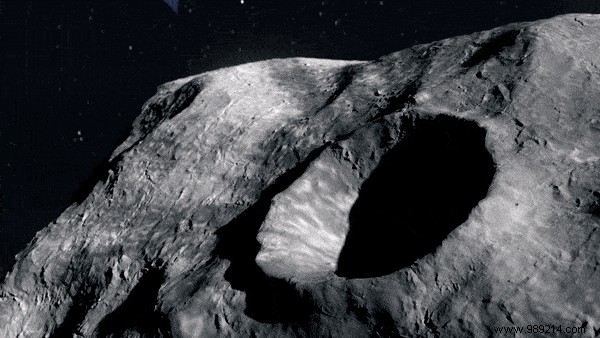Next fall, after traveling more than seven million miles, a ship will pounce on a small asteroid in an effort to alter its trajectory in the frame of the DART mission. A few years later, a probe named Hera, launched by the European Space Agency, will assess the consequences of this impact.
One of the advanced options to defend ourselves against possible asteroid threats suggests changing the trajectory of the affected objects. To assess the potential of this option, NASA and the European Space Agency (ESA) developed the DART mission (for Double Asteroid Redirection Test). The mission wassuccessfully launched this Wednesday, November 24 aboard a SpaceX Falcon 9 rocket from California.
In the fall of 2022, the DART spacecraft will orbit a pair of binary asteroids consisting of a 780m diameter "parent" object around which evolves a small rock of 160 m. The objective of this mission will be to crash into this small moon in order to modify its orbit. The team will observe this change in trajectory by measuring its degree of reflectance (change in its luminosity).
On site, a small CubSat, developed by the Italian space agency, will photograph the event by detaching itself from the DART spacecraft ten days before impact. We have already discussed this in a previous article. Today, we are focusing on the third and last probe integrated into this mission.
Developed by the European Space Agency (ESA), the Hera spacecraft will be responsible for mapping the DART impact crater .
According to the original plans, Hera was to witness the DART ship's suicidal encounter with the small moon. However, initial hesitation by ESA Member States led to funding delays. As a result, this ship will arrive much later.
According to the current plan, Michael Kueppers, in charge of the project at ESA, estimates that Hera will be launched in October 2024 to arrive on site at the end of 2026 or the beginning 2027 . It may not be so bad as the dust generated by the impact will have had time to dissipate, giving the probe a clearer view of the consequences of this event.

In addition to confirming the measurements of the small Italian CubSat , Hera could also tell us a lot about these two asteroids. Indeed, if we know today their orbit and their respective size, we still do not know anything about their shape and their mass . We also have no information on their composition and chemistry .
We do have a few guesses. In particular, astronomers believe that the largest asteroid does not appear as a single solid block of stone, but rather as a conglomeration of rocks and pebbles held together loosely by gravity. It may be the same for his little moon. However, this information can be crucial as part of a planetary defense plan.
Ultimately, the details collected by Hera will help researchers develop a possible future mission to deflect an asteroid on a collision course with Earth.